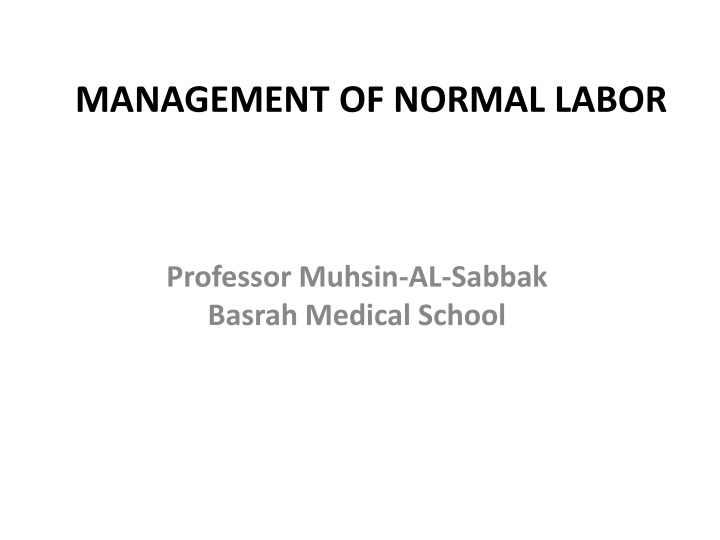Comprehensive Guide to the Management of Normal Labor by Professor Muhsin-AL-Sabbak
Understanding the management of normal labor is crucial for healthcare professionals. This comprehensive guide covers the definition of normal vaginal delivery, diagnosis of labor, stages of labor, phases of labor, and the use of tools like partogram and cardiotocography to monitor progress. Professor Muhsin-AL-Sabbak from Basrah Medical School provides valuable insights into the process, ensuring safe and efficient childbirth.
Download Presentation

Please find below an Image/Link to download the presentation.
The content on the website is provided AS IS for your information and personal use only. It may not be sold, licensed, or shared on other websites without obtaining consent from the author.If you encounter any issues during the download, it is possible that the publisher has removed the file from their server.
You are allowed to download the files provided on this website for personal or commercial use, subject to the condition that they are used lawfully. All files are the property of their respective owners.
The content on the website is provided AS IS for your information and personal use only. It may not be sold, licensed, or shared on other websites without obtaining consent from the author.
E N D
Presentation Transcript
MANAGEMENT OF NORMAL LABOR Professor Muhsin-AL-Sabbak Basrah Medical School
Definition:- Normal vaginal delivery means spontaneous birth of single term a life fetus on vertex presentation without the use of any instrumentation, episiotomy considered normal. Diagnosis of labor -Colicky sever lower abdominal pain rhythmic pain have the character of fundal dominance from the upper abdomen to the lower site with backache, the pain increased in intensity and frequency until it reach three contractions per 10 minutes, each lasted for 45-60 seconds. -Cervical dilatation and effacement (disappearance of cervical canal with subsequent uterine contraction.
- Passage of show which cervical mucus with blood (cervical plug) that present already to protect the fetus once contractions started this mucus plug will be dislodged associated with rupture of vasa previa (small B.V) that supply this plug. -Rupture of amniotic and chorionic membranes that lead to heavy leakage. Stages of labor Stage one:-It start from early signs of labor until the cervix became fully dilated (10 cm in diameter) Stage two:- It start from full cervical dilatation until delivery of the fetus. Stage three:- It means delivery of the placenta and membranes Stage four:- It covers one to two our observational period after complete delivery of the fetus and placenta to look for bleeding ,pain and so on.
Phases of labor: 1- Phase one (latent phase) it is the phase where there is cervical effacement it last up to 8 hours in primi-gravida and 2-4 hours in multiparous patients. 2- Acceleration phase :- In this phase there is rapid cervical dilatation about one cm/hr. and less in multiparous patient. 3- Platu phase the phase where cervical dilation reaches its maximum stage. Stage one:- After diagnosis of labor patient should be admitted to the labor room (observation stage). Looking for B.P, Temp. Pulse, fetal movement, if there is any vaginal bleeding with special partogram to plot the time of admission and progress of labor in cervical dilatation.
Partogram:- It is a special chart used in the labor ward in which we can check the progression of labor by plotting the time against cervical dilation and to see if there is delay in cervical dilatation or if there is any arrest of labor. The progression must be one Cm/one hrs., if there is delay or arrest in labor there will be no progression in cervical dilation. Cardiotocography:- It is special machine by which we could asses strength of uterine contraction and its relation to the fetal heart tracing. Normal fetal heart tracing includes:- -Beat to beat variation -Rapid acceleration of fetal heart on any fetal movement about 10-15 beat above the base line. -No any decelerations of fetal heart during or after uterine contractions.
Dip one means decelerations of fetal heart during uterine contractions and Dip two means fetal hearts remain decelerated after the uterine contraction had vanished by 15 seconds. Management of first stage also include I.V fluid if she had dehydration, pain killer, preparation of blood and observation chart. Artificial rupture of membranes if the head is well fitted to the cervix, the contractions should start half hour after rupturing the membranes if not then two units of syntocinon should be given with 500 cc glucose water and the starting drop is 15/min then increased to 30/min ,then to 60/min if no contraction noticed then we have to double the dose of syntocinon because more fluid will lead to water intoxication.
Second stage of labor we need only to assist the vaginal delivery and just to help her to manage the delivery by supporting the perineum during pushing to prevent perineal tear we need to do episiotomy which is an incision made to increase the diameter of birth canal especially the outlet to help the patient to deliver vaginally. It should be done when the perineum threaten to tear.
Active management of third stage of labor:- Syntometrine should be given with the delivery of anterior shoulder or crowning of the fetal head after exclusion of twin gestation. Wait until signs of placental separation which includes:- -Sudden gush of blood. -Elongation of the umbilical cord. -Globing of the uterus with hardening and became less in size. At that time then we use the Brandt`s Andrews method to deliver the placenta by sustained traction of the cord down word with the left hand pressing the fundus of uterus back word and down words.























